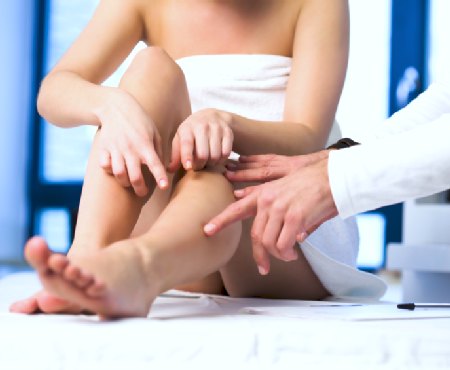superficial vein thrombosis
Venous
Insufficiency
Superficial
venous incompetence is the most common form of venous disease. In superficial
venous insufficiency venous blood escapes from a normal deep system and flows
backwards through dilated superficial veins in which the valves have failed.
The valves in superficial veins can fail for a variety of reasons including:
Direct
injury or superficial phlebitis may cause primary valve failure.
Congenitally weak vein walls, most often
inherited from your mother or father, may dilate under normal pressures to
cause valve failure (valve incompetence). Congenitally abnormal valves can also
be incompetent at normal superficial venous pressures.

Hormones, such as those in pregnancy may cause normal veins and valves to become excessively distensible and incompetent.
Superficial venous insufficiency may be asymptomatic but most often results in some or all of the following leg symptoms: swelling, throbbing, cramping, aching, heaviness, restless legs and leg fatigue. Over time, incompetent superficial veins may become visibly dilated and tortuous and are commonly referred to as varicose veins. In more severe forms of superficial venous insufficiency, more advance physical signs may occur and include skin hyper pigmentation at the ankles or lower leg, venous dermatitis, chronic cellulites and ulceration.
Varicose Veins
Varicose veins are enlarged veins that are swollen and may rise or bulge above the skin. They are dark purple or blue in color and can look twisted and cord-like. They can occur anywhere along the leg, but are most frequently found on the calf and thigh. They affect both women and men. While the exact cause is not known, there are several factors that predispose a person to developing varicose veins including heredity and hormone changes that occur during puberty and pregnancy. Additional factors include age, obesity, leg injury and prolonged standing.
Spider VeinsSpider veins are more superficial and smaller than varicose veins, are often red or blue in color and are closer to the surface of the skin. They can be unsightly and most often appear on the thighs, calves and ankles. Spider veins can be associated with aching, burning and swelling.
TreatmentA variety of noninvasive, minimally invasive and surgical treatments are used for the management of both clinically significant and cosmetic vein problems.
Endogenous procedures, utilizing radiofrequency or laser, are the mainstay for the treatment of venous insufficiency. These procedures are performed under local anesthesia with the addition of oral or intravenous sedation. The alternative to the these procedures is stripping of the saphenous vein which requires surgical incisions and is also associated with greater post operative pain and bruising. Closure procedure is patented technology that uses radiofrequency energy to occlude, or seal shut, the saphenous vein. Of the endogenous procedures, this is the most extensively researched and scientifically validated. There are no stitches involved, and most patients return to normal activity within a day or two.